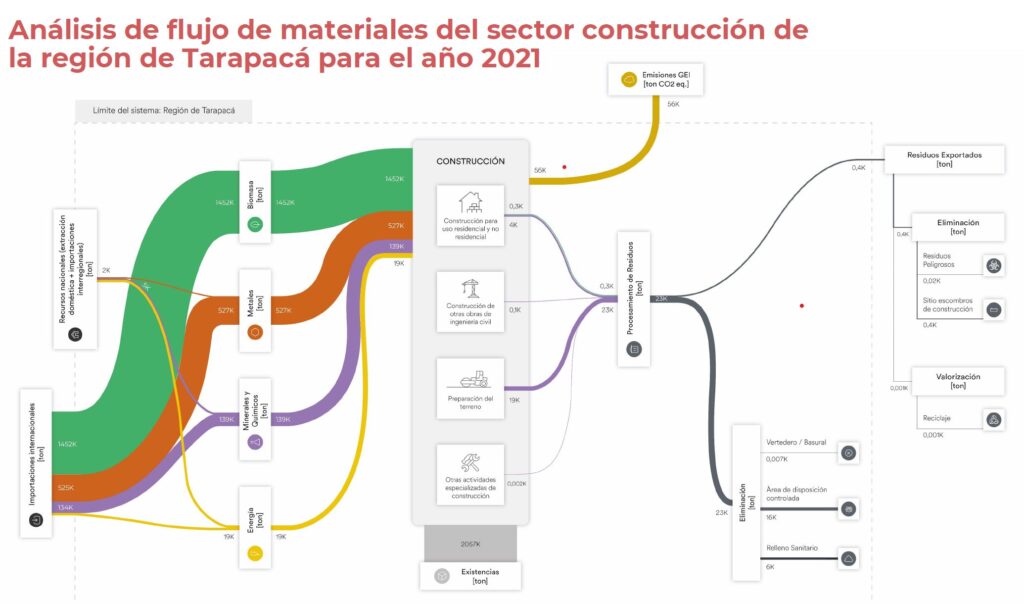Client
The assignment comes from CircularTec, the first technology center in Latin America and the Caribbean dedicated to accelerating the transition to a circular economy. It promotes research, development, and collaborative innovation based on the circular economy model to generate economic, social, and environmental value in the northern macrozone of Chile.
Tarapacá is a region in northern Chile composed of two provinces and seven communes. It has 369,806 inhabitants, 93.8% of whom live in urban areas and 6.2% in rural zones. It borders the Arica and Parinacota region to the north, Bolivia to the east, and the Pacific Ocean to the west. Its strategic location has supported the establishment of a Free Trade Zone (ZOFRI) in Iquique, the region’s capital, boosting foreign trade and promoting regional economic development. The region’s desert climate also creates favourable conditions for mining activity, especially copper extraction.
Repte
To diagnose the state of circularity in the Tarapacá region and, based on that, define strategic proposals to guide its transition toward a more circular and sustainable model.
What was done?
A governance mechanism was established to implement and monitor the project while aligning it with other existing objectives and strategies across different areas of authority. This governance mechanism included a technical advisory committee and a regional steering committee composed of public sector representatives and knowledge institutions. Key businesses and organisations actively participated in order to effectively implement the strategies and concrete actions.
One of the project’s first steps was an analysis of the region’s starting point in terms of circular economy. This involved mapping the ecosystem of key stakeholders and assets in the region and analysing the most relevant productive sectors in Tarapacá to assess their circularity potential. The sectors were prioritised in a co-creation session with local stakeholders.
The next step was applying a Material Flow Analysis (MFA) methodology to examine the two sectors with the greatest economic impact: mining and construction.
Finally, fourteen strategic action lines were defined and validated with key regional actors. These were organised into four broad categories: sustainable collaboration, awareness and capacity building, industrial transition, and innovation and knowledge promotion.
Results
1
Tarapacá Circular Vision 2040: By 2040, the Tarapacá region will strengthen the economic, social and environmental well-being of its territory and its inhabitants through the implementation of the circular economy model, aligned with the pillars of the Regional Development Strategy.
14
Strategic action lines across key focus areas. Examples include: Creating waste management and recovery infrastructure, Promoting efficient use of mining resources along the value chain, Developing circular economy training programmes for public institutions, Laying the foundations for circularity in the construction sector, Establishing a textile eco-innovation hub within the Iquique Free Trade Zone.
8
Key reflections on the region’s opportunities and needs to move toward a circular economy:
- – Circular economy: beyond technical and environmental—it’s a political challenge
- – Transforming production and consumption through circular economy
- – Data, transparency, and trust for circularity
- – Transforming waste management for a more resilient and self-reliant Tarapacá
- – The textile challenge in Tarapacá: a socio-environmental perspective for a just transition
- – The mining sector’s potential to lead the circular transition in Tarapacá
- – Strengthening training and entrepreneurship with a circular vision
- – Eco-design: a key to building a circular future
Conclusions
Thanks to this circularity scan, strategic proposals have been defined to guide the Tarapacá region along its path toward a circular model.
Moving forward, the engagement of public, private and academic stakeholders will be essential, along with proactive leadership from the Regional Government to align efforts, accelerate change and promote broad collaboration and innovation.

